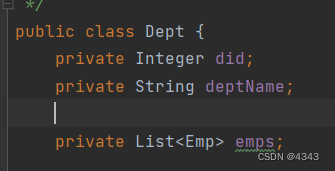一对多与多对一的区别:
以部门表为单位,一个部门会有很多员工为一对多的关系
以员工表为单位,会有多个员工在一个部门中为多对一的关系
一:collection
由于一个部门中会有多个员工,即一对多的关系因此我们需要的实体类Dept中存在一个集合属性,里面存放的数据类型为员工类型来存储多个员工

在resultMap中的映射关系为:
<resultMap id="deptAndEmpResultMap" type="Dept"><id property="did" column="did"></id><result property="deptName" column="dept_name"></result><!--collection 用来处理一对多的映射关系ofType:表示该属性对应的集合中的存储数据的类型--><collection property="emps" ofType="Emp"><id property="eid" column="eid"></id><result property="empName" column="emp_name"></result><result property="age" column="age"></result><result property="sex" column="sex"></result><result property="email" column="email"></result></collection></resultMap><!--Dept getDeptAndEmp(@Param("did") Integer did);--><select id="getDeptAndEmp" resultMap="deptAndEmpResultMap">select * from t_dept left join t_emp on t_dept.did = t_emp.did where t_dept.did = #{did}</select>这里使用了ofType,与之前多对一查询中不同的是ofType表示这个集合中存放的数据类型
而
中javaType表示多对一关系中的属性类型。两个场景不同的方法罢了
二、分步查询
第一步:查询部门信息
<!--Dept getDeptAndEmpByStepOne(@Param("did") Integer did);--><select id="getDeptAndEmpByStepOne" resultMap="deptAndEmpByStepOne">select * from t_dept where did = #{did}</select>通过查询到的部门信息中的did,来在员工表中查找对应的员工信息
因此,在resultMap中
<resultMap id="deptAndEmpByStepOne" type="Dept"><id property="did" column="did"></id><result property="deptName" column="dept_name"></result><collection property="emps"select="mybatis.mapper.EmpMapper.getDeptAndEmpByStepTwo"column="did"></collection></resultMap>需要指定第二步的sql语句的唯一标识以及查询的条件column did
<!--List<Emp> getDeptAndEmpByStepTwo(@Param("did") Integer did);--><select id="getDeptAndEmpByStepTwo" resultType="Emp">select * from t_emp where did = #{did}</select>:项目演示)

:知识回顾)

:双向绑定的案例图示分析)


:watch实现)







)



